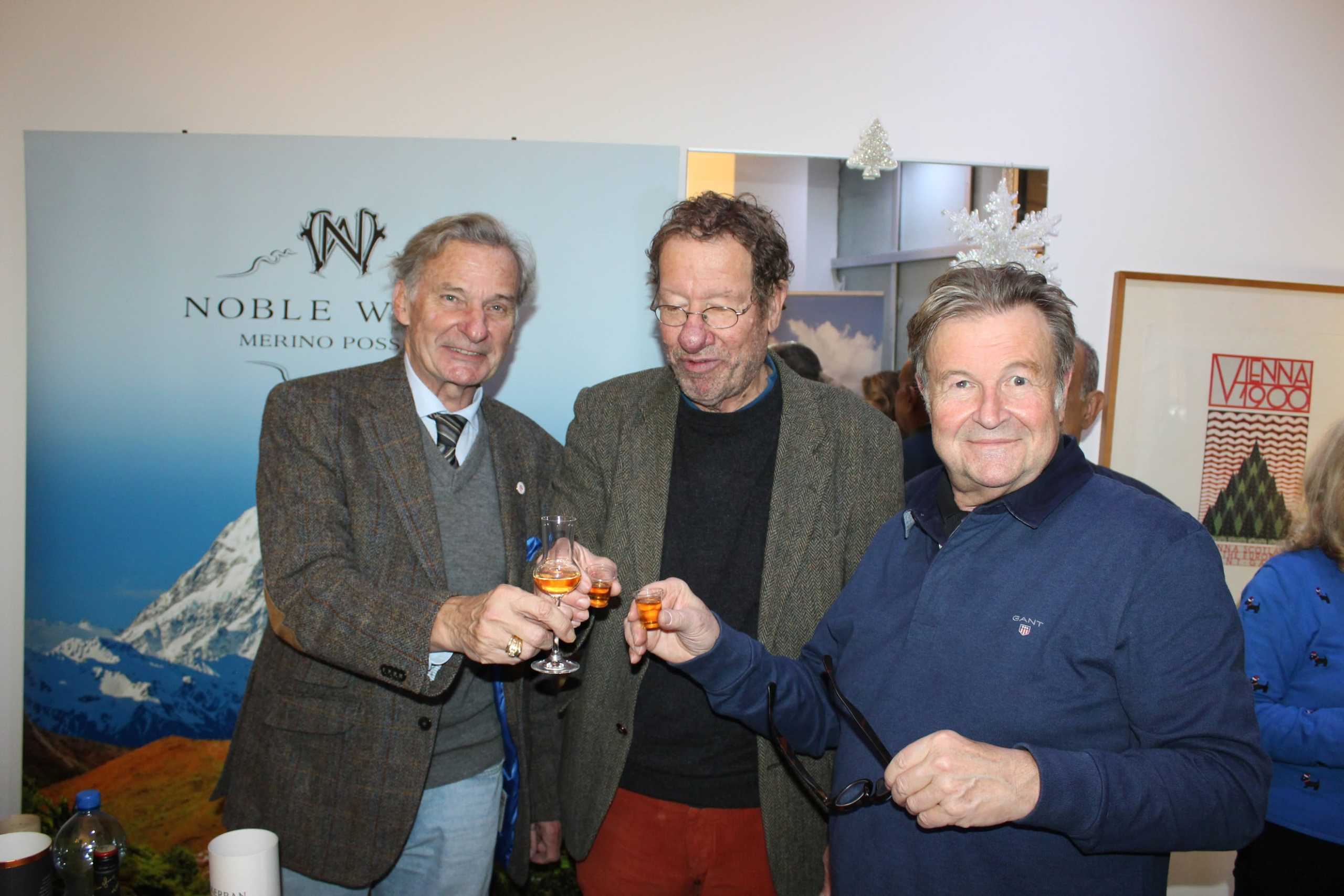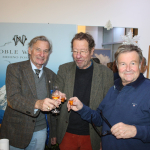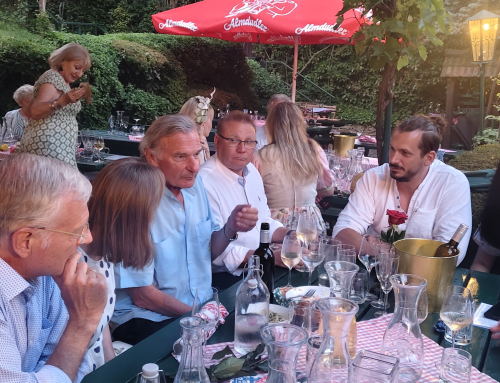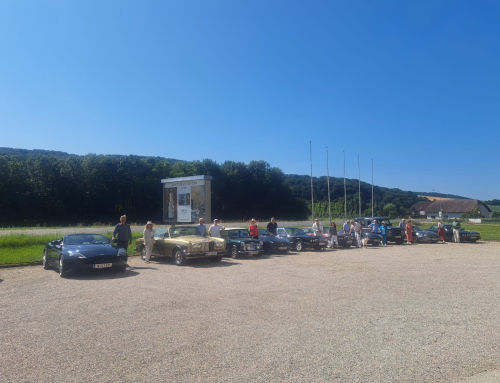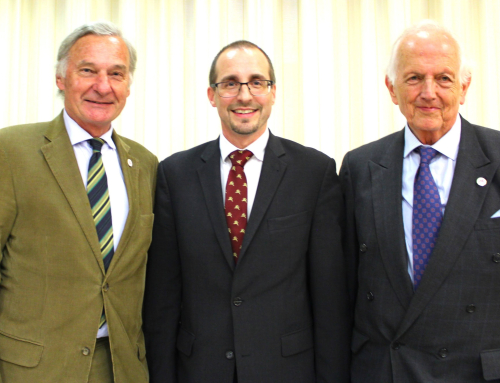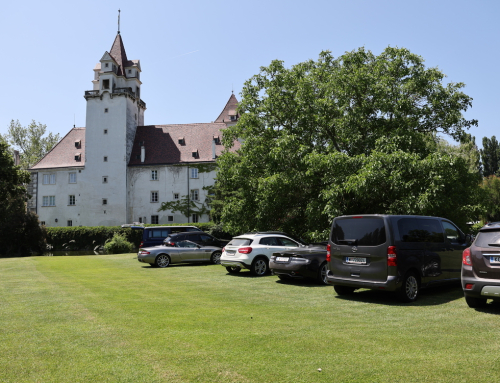(Review of the Talk “England, Scotland and the bit in between: the Anglo-Scottish border in the Middle Ages” on 19 December 2022 by Dr Daniel Talbot in the House of Scotland, Krugerstrasse 10,1010 Wien.)
By Wolfgang Geissler
The annual visit to „The House of Scotland“, the famous Pop-Up Store, this time at 10, Krugerstrasse in Vienna’s First District, is already a much-loved tradition. Once again, Peter Bichler welcomed us as the proprietor and introduced us to his valuable assistant, the textile specialist Ines Bogensperger. There was a sharp intake of breath by the members as Peter Bichler dug into his trouser pocket to pull out a little box about to present it to Ines. It was not a ring and the associations connected to that but a pin with the Scottish saltire, the „Ehrennadel“ of The House of Scotland.
Prof Dr Kurt Tiroch, our president, was able to say a few words of welcome after Peter Bichler’s introduction.
Let me now turn to the main event of the evening:
„The English have lost their sense of themselves as an ancient shared culture… In English schools, history is taught in a strangely episodic manner – Roman, Tudors, Second World War – so students have no continuous historical narrative… The English don’t even know their country geographically. Most southerners have little interest in what goes on up north, and most northerners wouldn’t be able to find Guildford on a map.“ Thus bemoans Louis de Bernières, an English novelist, the state of his country in the Financial Times on 29 January 2020. That Louis de Bernières describes himself as a Eurosceptic and supported Brexit deserves some mention.
Well, we know almost to the hour when England emerged from archaeology and entered history. At dawn on 27 August 55 BC – about fifteen long generations ago – a fleet appeared out of the night off Ebbsfleet in Kent, bearing none other than Julius Caesar.
Caesar and his army didn’t stick around, but the elite of Britannia were suitably awed. Some thirty years later, the Greek writer Strabo described Britannia as virtually a Roman property, whose chieftains came to dedicate offerings in the Capitol. By 43 AD, Emperor Claudius decided that it had developed enough to be worth invading and taxing properly.
Claudius really only cared about the tribes already advanced enough to be making and using coins. The limit of their territory is no coincidence. It is also the line of the Jurassic Divide, where young sandstones, clays and chalks give way to older shales and igneous rocks.
By 100 AD, the South East was a peaceful, prosperous colony. Its people, wrote the historian Tacitus, were obviously related to the Gauls. Beyond, to the north, were people clearly Germanic in origin, while those in the west were like the Iberians. It now occurred to the Romans – as it occurred to almost every later ruler of the South-East – that, since they controlled the richest part of the island, they should also rule those other peoples.
They failed. In what is today known as Scotland, resistance was so tough that the Romans fell back and built Hadrian’s Wall, which still entrances walkers.
So far, I have stolen this from „The Shortest History of England“ by James Hawes but now enter Dr Daniel Talbot with „England, Scotland and the bit between: the Anglo-Scottish border in the Middle Ages“.
History flashes past our eyes. Britain before England and Scotland consisted of many small kingdoms with fluid boundaries and periods of domination by various minor kings.
In 1017 King Cnut (Knute) took the whole government of England and became King of England or „King of the whole of England“ and divided it into four parts: Wessex for himself, East Anglia for Thurkyll, Mercia for Edric, Northumbria for Eric.
What is this thing of England that has a northern border? Off we fly to 1066 to the Norman Conquest. William the Conqueror now wants to know what it was he actually conquered. A gigantic survey, written in a book called the Domesday Book, eventually established England’s northern border.
Culturally it is more complex.
Bede, the Father of English History, wrote a book, „Historia Ecclesiastica Gentis Anglorum“ (c.731 AD) and described England as stretching further north than one would believe. West Lothian lay „in the territory of the English (regione Anglorum) but in the vicinity of the sea that divides the lands of the English (Anglorum terras) and the Picts.“
Hurrying up to release us to the much-awaited Whisky tasting, Dr Talbot concludes. Melrose Abbey, founded in 1136 by King David of Scotland, is located at the Scottish Borders. The Chronicle of Melrose records that the monks saw themselves as English, living in England and interested only in English events. Over the following hundred years, this changed. Now the monks saw themselves as Scots living in Scotland. Thus a clear cultural divide was finally established.
The wines were a donation by Peter Bichler and his House of Scotland. The tasty canapés served by our Café Ministerium and the Whiskies were presented, explained and poured by Dr Mario Prinz, Senior Whisky Advisor, owner and Managing Director of Potstill-Austria’s finest Whisky Store.
What an evening. But there is more to come. Wednesday, 21 December 2022, we all meet at the Hotel Bristol for the great Christmas Party of the Austro-British Society. See you there!
***
More Photos of the event HERE

